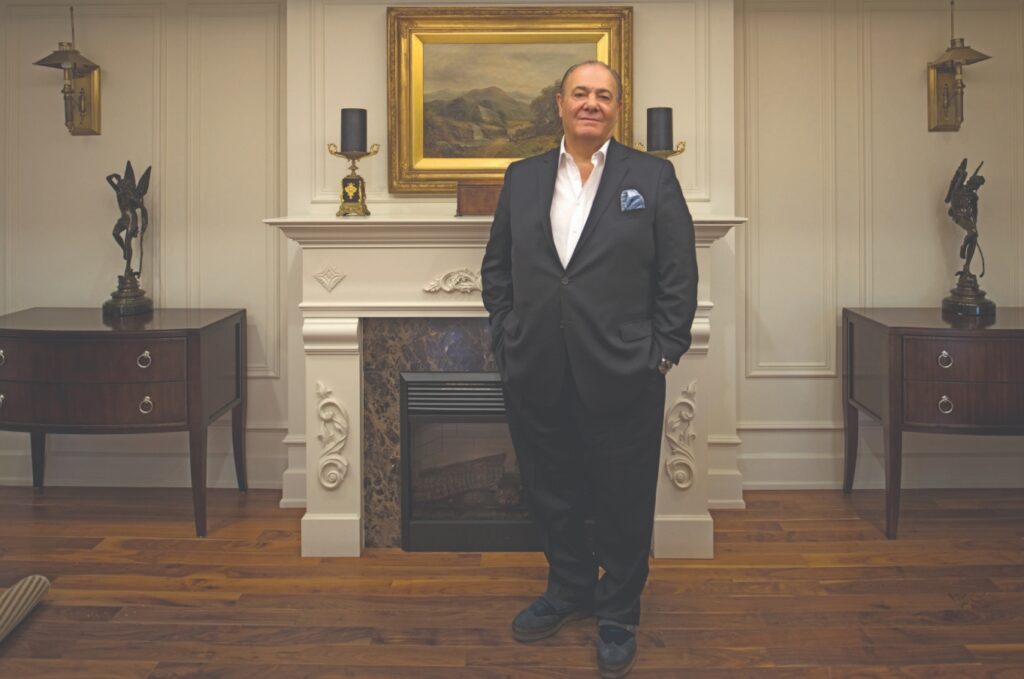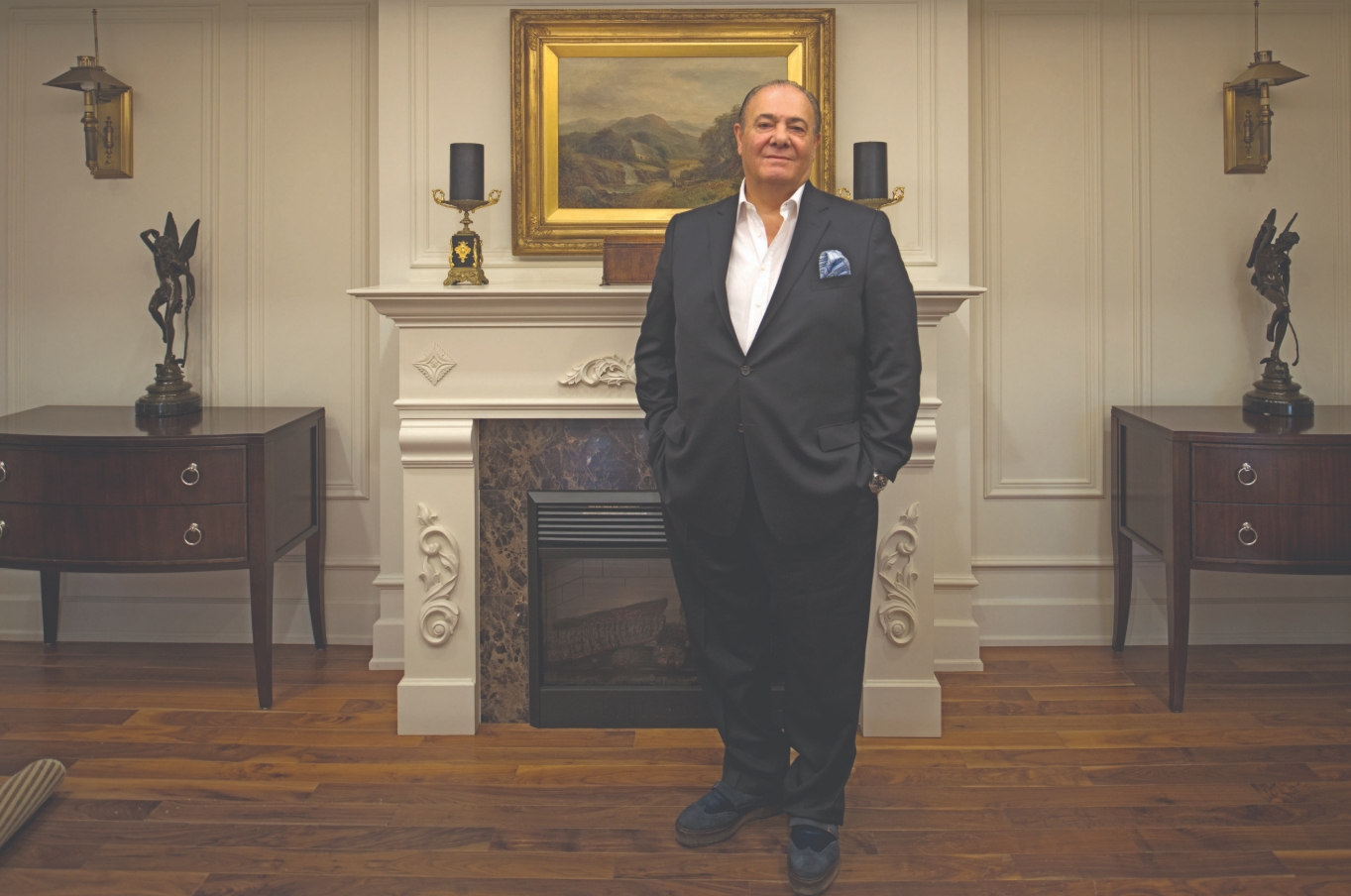
MEET SHANE BAGHAI, TORONTO’S FOUNDING FATHER OF LUXURY CONDOS
With over 40 years in the industry, Shane Baghai is well-regarded as Toronto’s original luxury builder. His St. Gabriel developments and The Residences of Avondale are North York icons and, after some time spent focusing on his Paradise Farms, he’s now set to make his mark in Leaside and Caledon. Doing it the Baghai way, Leaside Manor is a modern
mid-rise that stands out for its commitment to innovation and family-sized suites (there are no one-bedroom floorplans), and his take on country living in Caledon offers buyers a much-needed reprieve from the fast pace of city life.
The Collection: What first drew you to home building?
Shane Baghai: I was a mechanical engineer with no intention of getting into construction. But I dabbled in HVAC design and visited some trades in subdivisions. One thing led to another and they encouraged me to become a builder. My first lot was right behind York Mills Collegiate. I built a custom home and never looked back.
TC: You were not born or educated in Canada. How did you end up in the GTA?
SB: I studied in England. One day, I walked into our college and the Canadian Embassy had set up desks. They gave me a booklet, they gave me an application. I filled in the form, gave it back, and two weeks later they called me. That was 1973. They were looking for young educated people, people who had a young family. As much as I loved England, it was not the place for my children. I think we made the right decision. Canada’s been good to many people, especially those that suffered from being a minority in their original country.
TC: When did you get into multi-unit residential?
SB: In 1989, affordability was a problem. There was a boom that made custom homes in North York completely unaffordable. So, I decided to do things differently. I would compromise on the size of my units. In my mind, that was the only way to address this unaffordable situation and start selling…those expensive homes were not selling. So, I did two things. I started building luxury townhomes from 1,400 to 4,000 square feet, and I started talking to architects about high-rise buildings. The first was on Finch. I was fortunate to run into Arthur Erickson, a great Canadian architect who became my dear friend. He designed this beautiful building. A 40 unit midrise…a magnificent, contemporary, modern building, one of the first to have direct access from the elevator to the suite. The property was extremely environmentally sensitive and the authorities were careful in giving any permissions. Erickson was the perfect architect for that. He was a nature loving person who built many homes that blended into nature. We called it Watergarden and it was built under the most undesirable circumstances. Terrible winters, the recession, no bank wanted to assist me. It was like building and studying crisis management.
TC: How does that experience inform you moving forward?
SB: Housing is like the stock market in many aspects. Some people fall victim to over exuberance and mass-hysteria. Prices go up and someone looking to buy a condo gets excited and says ‘why shouldn’t I buy three?’ [But] economics is a complicated science. The situation in 1989 was different. To know the truth, you have to look at 1982 and 1983 where interest rates started going up to 20 percent. That was an experiment that governments did, playing with interest rates. They wanted to see what could stop inflation. Inflation was this dreaded disease and governments wanted to deal with it at any price. It was like a pilot flying a plane abruptly to see how it behaves. It shook a lot of people. Interest rates came down, and some politicians thought they conquered inflation. Well, it didn’t have to be as drastic. There was no inflation fear anymore…but the other dreaded thing that was about to happen was deflation. Nobody wanted to buy a house, nobody wanted to invest. So the government started loosening regulations and borrowing became easier. That resulted in the longest housing boom I’ve ever seen.
TC: Most people, with the exception of a few months in 2008, have no experience with a changing market.
SB: In 2008, we were all afraid. The hedge fund boys and the derivative experts put the United States in such a tormenting economic downturn that I thought the effects would jolt us, too. But Canada was different, particularly Ontario. We had other things happening. We had the McGuinty government insisting on love for the Greenbelt. The Oak Ridges Moraine basically created the towers in downtown Toronto. The city couldn’t expand like before. Building high-rises became fashionable, and what made them affordable was smaller space. People changed their lifestyles and were ready to embrace this big city way of life. Vancouver at the time was growing…our rival city. And in both cases, our governments wanted to show some muscle. The non-resident tax, the most stupid thing that anyone could think of, came and basically affected the market for a few days. Whoever needed to buy, bought; but we really discouraged investors from other places in the world that wanted to invest in Canada and who would one day become Canadian. Ontario shouldn’t have followed suit. The wheels of the economy turn because of construction. There are thousands of businesses that depend on construction. And the most dreaded thing for any government is unemployment.
TC: What are your thoughts on changes to lending criteria?
SB: The stress test is perfect. They want to tell you that we’re raising rates and we don’t want anyone to get caught. It’s very reasonable. But if construction activity drops, if there is unemployment, stress test or not, a lot of units may come back to the market. I don’t think that will be the case in Ontario…we have more people coming to reside in Toronto than any other city in Canada. Ontario also enjoys a lot of inter-provincial migration. So, we need to house people at the rate of 110,000 per year. The demand will always be there. But developers are upset about regulations and the time it takes to develop land. That is going to affect affordability more than anything else.
TC: How high can prices go? We’re hearing of projects in the pipeline at $2,400 a square foot?
SB: Toronto will handle it. I’ve seen examples between $2,000 and $2,400 for penthouse units in choice areas like Yorkville and around Yonge and Bloor. Builders have no choice but to build something that is viable and to build in Toronto is very expensive.
TC: If this is now a city of condos, I’m concerned there aren’t enough units built for families?
SB: You are 100 percent right. That is why our team and I decided our new project in Leaside will cater to all kinds of people, including people with children. We decided to go with two bedrooms and a den and three bedrooms and a den. A lot of people are interested in living there, people with a growing family. Kids could thrive in a 1,500 square foot apartment.
TC: Do we need to rethink common spaces to cater to children who don’t have readily available green space?
SB: Absolutely, in larger buildings. In our case, we have the Leaside Arena right next to us which is not only equipped with hockey, it has fitness and a playground… but I’ll tell you what really makes future buildings luxury and affordable and suited for families of all ages…Smart homes. The home has to be intelligent. Kids don’t want to carry a computer with them, they want to turn on a screen on the fridge, send messages to the concierge, open doors remotely, turn the car on from their unit. All kinds of magic, because they have all the controls under their fingertips. In Leaside, we want to make it user friendly. We’ve created an electronic concierge that opens doors remotely; monitoring station staff can see you on camera and they can be seen.
If you have a delivery, they open the door to the delivery room, you drop off the package and get out. In the meantime, they’ve filmed it, so security is assured.
TC: You’re also active in Caledon.
SB: On one hand, I’m building a building that is compact, efficient, and geared to people who want to live in a metropolis. On the other hand, this dream of two acres or 50 acres was getting further away from people’s ability to purchase. When I bought a farm in Caledon, I realized that it takes me 45 minutes to drive there from Yonge and 401, and what I saw that I couldn’t find in Toronto were large tracts of land. In this case, two homes…one on 21 acres, the other on 60 acres. The homes are about 6,000 square feet and have very unique architecture. I call them Country Modern. The exterior is country…stone and wood, but inside is a very modern space. So, we have these wonderful homes ready for viewing and they offer something you can never find in the city. I like to be in both markets. The luxury condo market and this palatial setting.
For more information on Shane Baghai,
visit www.shanebaghai.ca

